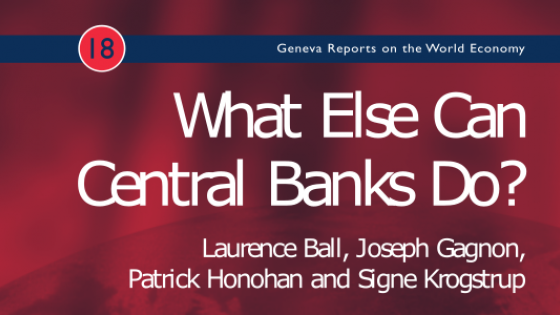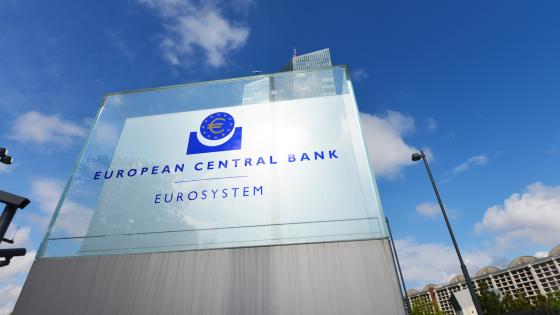During the Great Moderation period from the mid-1980s to 2007, economists grew confident that central banks could stabilise economies by raising and lowering short-term interest rates. A startling development during the Great Recession of 2008-2009 was that policy rates in advanced economies fell to near zero (Blanchard et al. 2016), yet that was not sufficient stimulus to promote strong recoveries. Rates have stayed near zero in many countries, suggesting a liquidity trap: further stimulus is needed, but central banks’ traditional tool of policy rate cuts is not available.
In the:
we examine the liquidity trap, or lower bound on interest rates (Ball et al. 2016). We first document the severity of the problem – how it has constrained monetary policy since 2008, and how it is likely to constrain policy in the future – and then discuss how central bank policymakers can respond. Contrary to the common view that central banks are “out of ammunition” when policy rates fall to zero, we believe they can provide stimulus, notably by pushing rates negative and through aggressive forms of quantitative easing (QE). Looking further ahead, policymakers can greatly reduce the danger of the lower bound by a modest increase in their inflation targets.
The danger of the lower bound
There is little doubt that the lower bound on interest rates has constrained monetary policy since 2008. For the US, for example, a pre-crisis Taylor rule dictates a federal funds rate of -5% or -6% in 2009. The actual rate never fell below zero. Based on a simple macroeconomic model, we estimate that US unemployment rates from 2009 through 2015 averaged more than a percentage point higher than they would have if there were no lower bound on interest rates. Unemployment would have been higher still if not for the Federal Reserve’s policy of quantitative easing (discussed below).
A crisis of that magnitude is not necessary for the lower bound to constrain monetary policy, however. Our report emphasises that, going forward, even modest economic downturns are likely to push interest rates to zero. This prospect is the result of two factors. One is the low inflation targets chosen by central banks, typically close to 2%. The second is the apparent fall in the neutral real interest rate over the last two decades, to current estimates of about 1% or even lower. Together, these numbers imply that the steady state nominal interest rate is 2 + 1 = 3%. Starting from this level, a central bank can reduce its policy rate only 300 basis points before hitting zero – not enough stimulus to offset a moderate-size shock to the economy.
Using our simple macro model, we estimate that a zero bound on interest rates is likely to constrain policy whenever unemployment rises 1.1 percentage points above its natural rate. An increase of this magnitude is a very modest downturn; over the last 50 years, for example, six of the seven US recessions pushed unemployment above the natural rate by more than 1.1 points. The Eurozone does not have as long a history to establish regularities, but there is no reason to suppose a significantly different pattern. If recessions occur as frequently in the future as they have in the last half century, advanced economies will frequently find themselves with weak economies and central banks unable to provide conventional stimulus.
Monetary stimulus near the lower bound
Central banks are far from helpless when interest rates are near zero. Our report considers a number of tools that policymakers can use to provide stimulus in this situation, and emphasises two of these: negative interest rates and quantitative easing. These tools have already been employed to some extent, with positive results, and they could be more effective if used more aggressively.
We have learned in the last several years that zero is not an absolute lower bound on interest rates. Several central banks have pushed their policy rates below zero; Switzerland’s rate is currently the lowest at -0.75%. These negative rates have transmitted to domestic asset prices and the exchange rate in much the same way as cuts in policy rates have done when they were still positive. Moreover, concerns about the impact of negative policy rates on the functioning of the financial system have not been validated in practice to date. It seems likely that rates can be pushed even lower than has been attempted so far, at least by a modest amount, without unduly adverse side effects.
Quantitative easing programmes have already had substantial effects in the countries that implemented them. In the US, for example, it is estimated that QE purchases of long-term bonds between 2008 and 2015 had macroeconomic effects equivalent to those of a sustained reduction of about 200 to 250 basis points in the policy rate. With a greater volume of purchases, the effects can be greater.
Beyond government bond purchases, QE can be expanded by including risky assets such as corporate debt and equities. For given quantities of asset purchases, broader versions of QE could well have stronger effects on asset prices and costs of funds, and hence on economic activity, than purchases of government bonds.
Potential side effects of expansionary monetary policy have been stressed by some commentators. These include the risk of an overshoot resulting in a surge of inflation, the danger of asset price bubbles, disintermediation of the banking system (and hoarding of cash), challenges to the profitability of banks and/or the central bank, the potential for loss of monetary policy independence and perceived distributional impacts. Despite banking industry grumbles, there is so far little evidence of significant net adverse side effects. In general, such risks are lower in the depressed conditions that normally accompany a liquidity trap; should they occur, the most important side effects can be mitigated or managed. Besides, the sooner economic recovery is achieved, the sooner these policies will become unnecessary.
A higher inflation target
Although policymakers have tools for stimulus at the lower bound, these may not always be enough. We therefore also consider adjusting policy frameworks to reduce the risk that nominal rates hit zero. Of the many proposals out there, the most obvious and simplest of such adjustments would be a modest increase in central banks’ inflation targets. Raising the target would raise the steady state nominal interest rate, giving policymakers additional scope to ease policy in response to adverse shocks.
As an example, we simulate how the Great Recession in the US would have been different if the Fed had entered the episode with a 4% rather than 2% inflation target. Given the magnitude of the shock, the federal funds rate would still have hit zero quickly, but with higher inflation, the real rate would have been more deeply negative. As a consequence, the economy would have recovered more quickly. The zero-bound episode would have been shorter: the federal funds rate would have risen above zero in 2011, rather than late 2015 as in actual history.
A review of the evidence suggests that the costs of a modest increase in the inflation target are slight. For example, shoe leather costs, relative price variability, and complications in long-term planning all appear small at inflation rates under 5%. There is also little evidence suggesting that the variability of inflation around a slightly higher target would be larger. Indeed, a higher inflation target might well reduce uncertainty about inflation. In recent years, inflation uncertainty has been high, reflecting worries that deflation may set in, and also worries that unconventional easing may eventually produce a sharp rise in inflation. A higher inflation target, by moving the economy away from the lower bound, would help return us to a regime in which markets are confident that the central bank can stabilise inflation through interest-rate adjustments.
Perhaps the most common reason that policymakers have resisted raising the inflation target is the concern that credibility will suffer. We believe this concern is unwarranted and misplaced. Central banks should seek credibility for their commitment to meet their ultimate goals – full employment and price stability – not for their commitment to a particular number for the inflation target. A greater risk to central bank credibility may be the protracted inability to meet their mandates at the current low targets, due to the lower bound constraint.
How should the target be chosen? In the early 2000s, central banks concluded that a weighing of the costs and benefits of inflation, and the risk of reaching the lower bound on interest rates, justified targets around 2%. A new analysis accounting for the experiences of the last decade – the Great Recession and the apparent fall in the neutral real rate – would likely find that 2% is too low. To best choose a target that takes into account changing circumstances, central banks could perform systematic reviews of the policy framework on a recurrent basis, perhaps every five years. Such a review, we believe, would currently be likely to conclude that moderate increases in inflation targets are necessary for central banks to best meet their mandates.
Conclusion
In the past, belief in the impotence of monetary policy has been a common and dangerous fallacy. Today, policymakers are tolerating underemployment because of doubts about the effectiveness of monetary stimulus, and exaggerated fears of side effects. Overcoming these tendencies would help the world’s economies avoid future lost decades.
References
Ball, L., J. Gagnon, P. Honohan and S. Krogstrup (2016), What Else Can Central Banks Do?, Geneva Reports on the World Economy No. 18, ICMB and CEPR.
Blanchard, O., D. Furceri and A. Pescatori (2014), “A prolonged period of low real interest rates?”, VoxEU.org, 15 August.







